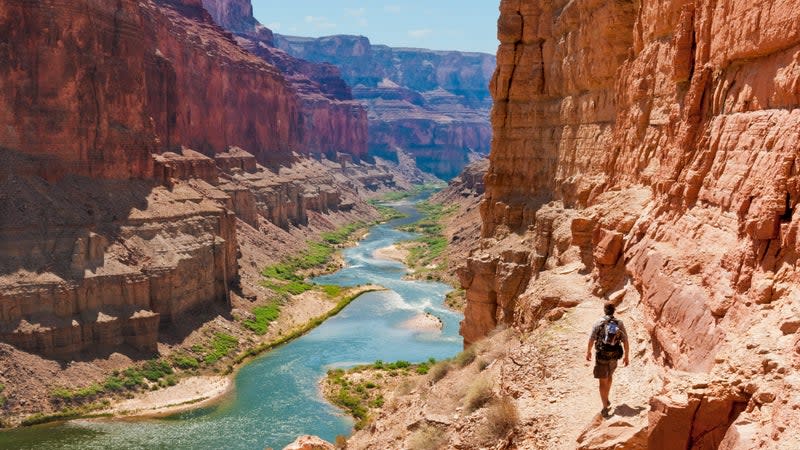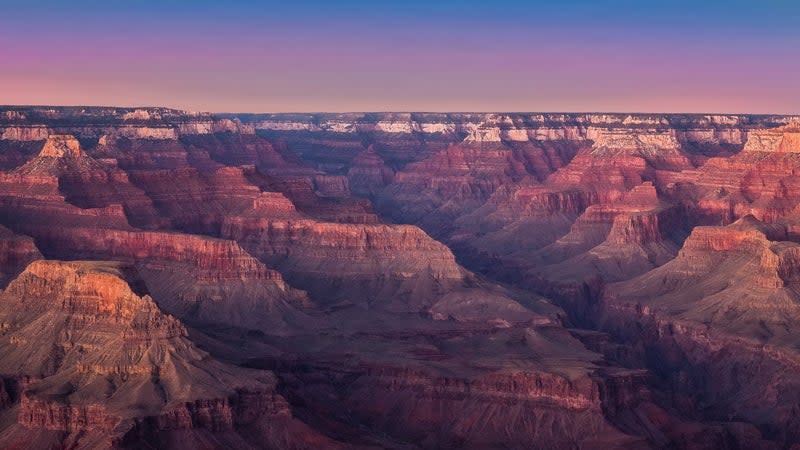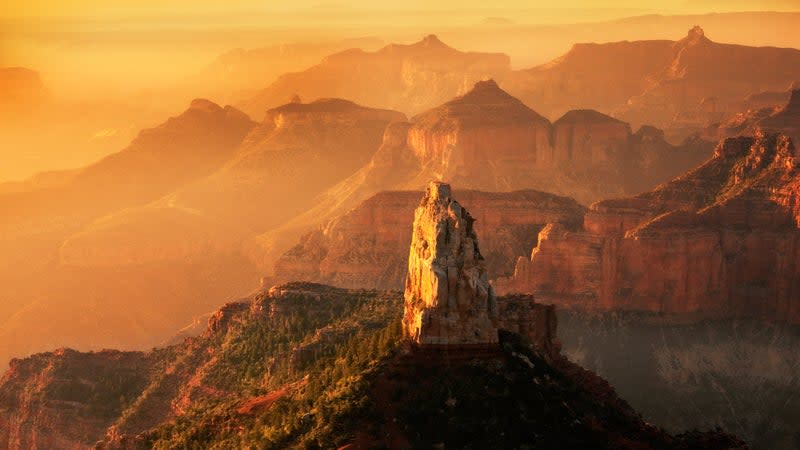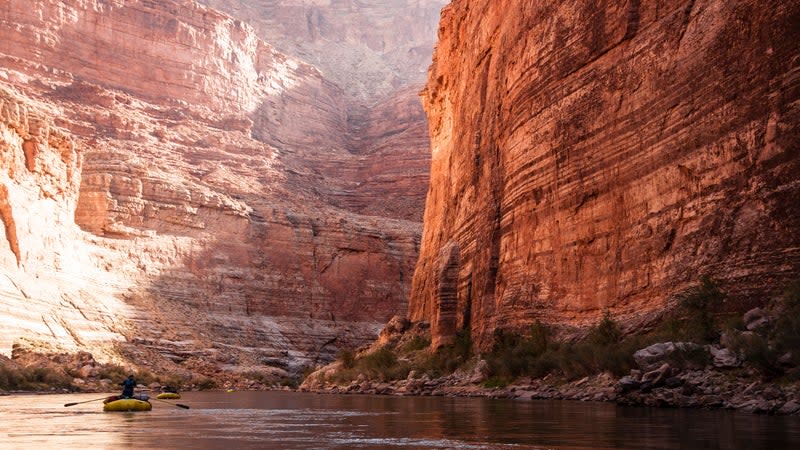The Ultimate Guide to Grand Canyon National Park
This article originally appeared on Outside
No wonder Teddy Roosevelt called the Grand Canyon "the one great sight which every American should see." Walk to its edge, and the earth falls away into an expanse of peaks, plateaus, and gorges so vast it can be disorienting. Descend below the rim, and the sense of awe only grows. The canyon is essentially an inverted, 6,000-foot, 277-mile-long mountain range, where you are dwarfed by sheer stone walls stacked to the sky and vistas that multiply with every turn. In the desert landscape, the water can be the most astonishing sight. Turquoise streams rush whole out of rust red cliffs and cascade through travertine pools. At the bottom of the canyon, of course, lies the engine of this great geological conundrum--the thrumming, persistent Colorado River, which carved the gorge over millennia. If there's a better place to gain perspective on our own relative insignificance, I don't know it.
But all this comes with a downside. The park gets crowded. More than 4.5 million people visited in 2021 alone. Don't let that stop you from planning a trip, though. Just a fraction of visitors bother to descend into the canyon itself, which means it's easy to find solitude. But with 595 miles of established trails, 278 miles of river to float, and countless panoramas, historic sites, and overlooks to explore, it's hard to know where to start. Here's how to make the most out of an adventure to one of our country's most rugged and iconic places.
What You Need to Know Before Visiting the Grand Canyon

Beware of the heat.
The interior of the canyon averages triple-digit highs June through August, and those temperatures contributed to 82 rescues in 2017 alone. So unless you're a reptile or riding in a raft, plan your visit for the other nine months of the year.
If a summer trip is your only option, head to the North Rim.
The North Rim gets about a tenth of the visitors and, at an elevation of 8,297 feet, runs nearly ten degrees cooler than the South Rim. In fact, all park amenities on the North Rim are closed November through April, and the road into the park closes in December--or earlier if enough snow falls--meaning you can only access the North Rim by hiking, snowshoeing, or cross-country skiing with a backcountry permit.
Be prepared for some paperwork and hope for some luck.
Many of the park's best adventures, like camping in the backcountry, running your own trip down the Colorado's rapids, or spending the night at the Phantom Ranch at the canyon's bottom, require winning a lottery to land the necessary permits.
Rafting Permits in Grand Canyon National Park
If you know your way around an oar rig, the odds of winning a permit for a noncommercial river trip are notoriously difficult, especially for popular times like autumn and spring. For example, there were 459 applications to launch on September 18, 2019, alone. On the other hand, some days in December, when the days are short and the nights are cold, see no applicants at all. No matter your launch date, it costs $25 to apply for a permit. If you win, a $200 to $400 deposit must be paid immediately and is applied to your trip's final price tag, which will depend on the size of your group.
Backpacking Permits in Grand Canyon National Park
Your odds for scoring overnight backpacking permits are much better and only cost $10 per permit, plus $12 per person per night in the canyon or $12 per group above the rim. A word of note on this, though: the park's reservation system is still dependent on pre-Y2K technology, meaning you have to apply via fax, regular mail, or in person. Your best chance for landing your dream hike is sending in a written application a little over four months before your planned trip during what's called the earliest consideration period, which starts on the 20th of every month and runs through the first of the next. Trip applications submitted during this time are rewarded through a lottery. After that it's first-come, first-served. Don't fret if you don't snag the spot you want, and definitely don't cancel your trip. Most people don't know it, but once you receive your permit, you can call the backcountry office to try and modify it. The nonprofit Grand Canyon Trust has a good explainer of the byzantine system here.
How to Get There

Grand Canyon National Park is split into two distinct zones divided by, well, the actual canyon. It's a long four-and-a-half-hour drive to get from one rim to the other, so plan carefully. If you're visiting the North Rim, it's quickest to fly to Las Vegas, a four-and-a-half-hour drive from the park. If you are bound for the South Rim, from Phoenix it's a three-and-a-half-hour drive, or you can splurge on one of the few daily flights into Flagstaff, Arizona, just an hour and a half south of Grand Canyon Village, the main hub for exploring the park. No car, or prefer not to drive? Groome Transportation runs vans from Flagstaff to the village three times a day from May 15 to October 16.
Where to Stay In or Near the Grand Canyon

South Rim
El Tovar is a landmark, not only for its location just steps from the canyon rim but also for its iconic architectural style, which influenced many of the National Park lodges that followed. Built in 1905, it's worth taking a look at the log-sided lobby, even if you aren't staying there. Like most NPS lodging, rooms are basic, expensive, and hard to come by (from $394). You'll want to book a year in advance, especially if you covet one of the three balcony suites on the canyon side, which cannot be reserved online. You'll have to call the hotel directly, and they'll cost you double the regular room rate. There are five other hotels on the South Rim, all pretty basic, and another half dozen in the town of Tusayan, just outside the park, about six miles from the rim.
For camping on the South Rim, your best bet is to head 25 miles east of Grand Canyon Village for the prized sunsets at Desert View Campground. It runs $18 per night but is first-come, first-served, so plan to snag a site midmorning when campers are clearing out.
North Rim
Go for the Western Cabins at the Grand Canyon Lodge. With nothing between your front porch and the canyon but a few pine trees, cabins 301, 305, 306, and 309 are some of the best accommodations in the park ($271, open May 15 to October 15). If those are booked, grabbing an Adirondack chair from the main lodge's veranda and settling in as the sunset washes the Deva, Brahma, and Zoroaster Temple buttes in flaming alpenglow is a solid second choice.
You can catch the same west-facing views at the North Rim Campground, a mile or so north of the lodge. Book sites 14 to 19, right on the rim, if you can, though they're often reserved a year in advance.
Canyon Floor
The Phantom Ranch, tucked into a shady cottonwood grove at the bottom of the chasm, switched its reservation system to a lottery in 2018, and entries are due a whopping 15 months ahead of your desired dates. If you don't make the cut, try for a spot at the adjacent Bright Angel Campground, which requires a backcountry camping permit. You can still order meals from Phantom Ranch, which will lighten your load for the hike in.
The Best Adventures in Grand Canyon National Park

Most park visitors never leave the developed enclave of Grand Canyon Village on the South Rim. They roll up in their rental car, park, stroll to the guardrail rim, browse the gift shops, and then head to the next national park on their checklist. That's not an exaggeration: the park estimates that the average visit lasts less than four hours. Even hopping on the free shuttles that stop for fresh views along the South Rim every mile or so is enough to leave most of the horde behind. The farther you get from the visitor center, the more the crowds thin out.
Biking Routes
Rent bikes from Bright Angel Bicycles, located next to the visitor center, and cruise the South Rim. The Hermit Road winds seven miles along the rim from the village and is closed to private cars March through November, making it one of the most scenic cycling paths in the world. Or head east from the visitors center and link the bike path with the car-free Yaki Point Road. Jutting far into the canyon, Yaki Point is a popular spot to catch the sunset splash rosy light across a 42-mile swath of canyon all the way from the Palisades of the Desert, 25 miles to the east, to Havasupai Point, 17 miles west.
Hiking Trails
For day outings, skip the South Rim's well-trampled Bright Angel Trail, which drops into the canyon right at the village, and take the shuttle bus from there to the South Kaibab Trailhead. The seven-mile path, one of the best hiking trails in Grand Canyon National Park, descends 4,780 feet all the way to the river, but many people merely opt for the 1.8-mile round-trip to the comically named Ooh Aah Point. On the North Rim, the mild five-mile Widforss Trail winds along the rim and then ducks through ponderosa pine and aspen groves to Widforss Point, where you can catch views of sheer, jagged buttes like Wotans Throne and the Zoroaster Temple or the battlements of Transept Canyon.
Backpacking Trips
The remote, arduous Thunder River Trail may well be the Grand Canyon's most astonishing backpacking trip. Start the 21-mile, three-day loop from the Bill Hall Trailhead at Monument Point (which shaves 2.5 miles off the traditional Indian Hollow Trailhead route), 34 miles down a sometimes impassable road from the North Rim town of Jacob Lake. It passes by Thunder River itself, a large creek that pours straight out of cave midway up the red canyon wall and tumbles down tiers of lush, vegetated pools. Don't miss the chance to spend an afternoon exploring the twisting Deer Creek Narrows, or detour down the rafter's trail to the river to check out the outlet of the narrows, 80-foot-high Deer Creek Falls.
The granddaddy of Grand Canyon hikes is going rim to rim, dropping all the way to the river, crossing the bridge at Phantom Ranch, and then climbing out the other side. Some break up the journey with a night at Phantom Ranch. Others prefer to knock it out in a day--the current record is two hours and 39 minutes. To preserve knee cartilage, most people start at the lower South Rim, descend 4,460 feet on the Bright Angel Trail, and then ascend 5,850 feet on the North Kaibab Trail to the North Rim Lodge, for a total of 21 miles. Some of the more ambitious hikers and runners go rim to rim to rim, but for the one-way trip, you'll need transportation back. If you can't talk a friend into picking you up on the other side (a four-and-a-half-hour drive one-way), you can drop a car off yourself and catch a ride back with the Trans-Canyon Shuttle for $120.
Boating and Paddling
There are two ways to boat the Colorado River: by motorized raft or in a human-propelled oar or paddle raft. I can't recommend the former. The outboard engines feel like a violation of the river's stretches of sublime silence, and the huge 30-foot rafts--packed shoulder to shoulder with passengers--mute even the formidable whitewater.
The best way to experience the river is at its own pace, taking on the towering waves of famous rapids like Crystal and Lava Falls in an 18-foot oar rig. You'll drift for days through face-melting scenery, blast down hundreds of galloping rapids, and camp each night on sand beaches beneath a lane of bright stars. Plus you can pack steaks and fresh veggies in coolers, chill beers beers in drag bags in the river, and best of all, enjoy the complete lack of cell-phone reception. If you don't have the experience or a permit to DIY, more than a dozen commercial companies including OARS and AZRA run river trips through the Grand Canyon, ranging in length from three to 18 days and costing around $2,000 to $6,000.
Where to Eat and Drink Near the Grand Canyon

If you're driving up from Phoenix, stop in Flagstaff, a college town with a burgeoning food and brewery scene. For lunch, pop by Diablo Burger for locally sourced beef patties served on English muffins, and grab a Blake, which features homemade Hatch-chile mayo, roasted green chilies, and sharp cheddar. Staying for dinner? The folks at Satchmo's say their fare is good for the soul--cast-iron cornbread, jambalaya, and slow-smoked barbecue are all on the menu.
Inside the park, dining options are mainly limited to large-scale concessionaires who win service-contract bids. Xanterra, which runs most of the Grand Canyon's restaurants, now sources 40 percent of its ingredients from sustainable or local vendors. At the El Tovar dining room, the signature prime-rib hash--which features Arizona-grown beef, cage-free eggs, bell peppers, and chipotle hollandaise sauce--should set you up for a descent into the canyon and back.
Bright Angel Bicycles in Grand Canyon Village sells Flagstaff-made baked goods, sandwiches, and coffee. The cinnamon pound cake is worth stashing in your pack for a midride snack.
Across the canyon, the view from the veranda at the Grand Canyon Lodge makes for some of the best alfresco dining on the planet. From the dinner menu, try the wings, which are braised in spicy prickly pear cactus juice. Wash it down with Flagstaff-brewed beers named after park features, like the Phantom Ranch Red.
Just outside the park, the Meadows Edge Coffee Trailer, beside the North Rim Country Store, serves a blueberry-pomegranate smoothie and the canyon's best latte. A little farther on, at the junction of 89A and Highway 67, the Jacob Lake Inn is famous for its cookies. There are 15 varieties on offer, including chocolate parfait and lemon zucchini with pecans.
If You Have Time for a Detour

While getting a permit to float through the Grand Canyon takes some doing, paddling 15 miles upstream from the park into Marble Canyon requires no permits, fees, or reservations. Dogs are also allowed, so you can finally let the pups out of the van.
For camping, part of Glen Canyon National Recreation Area (the section of river between Lee's Ferry and Glen Canyon Dam) contains first-come, first-serve sites. Or relatively strong paddlers can rent a kayak from Hidden Canyon Kayak in nearby Page, Arizona, and head upstream to camp in the Instagram mecca that is Horseshoe Bend. From the beach, you can just make out the silhouettes of the hordes on the rim.
Want to mountain bike at the park? You can't. But the Rainbow Rim Trail, on Forest Service land abutting the North Rim, has become the go-to destination for fat-tire riders wanting to cozy up to America's favorite abyss. Twenty-two miles of singletrack wind through ponderosa pine forests and meadows, occasionally popping out at the rocky rim for eyefuls of the Big Ditch. Most cyclists post up for a few days at dispersed car-camping spots like Locust Trailhead, midway on the route.
Editor’s Note: We frequently update this National Parks guide, which was originally published on Dec 4, 2018.
For exclusive access to all of our fitness, gear, adventure, and travel stories, plus discounts on trips, events, and gear, sign up for Outside+ today.